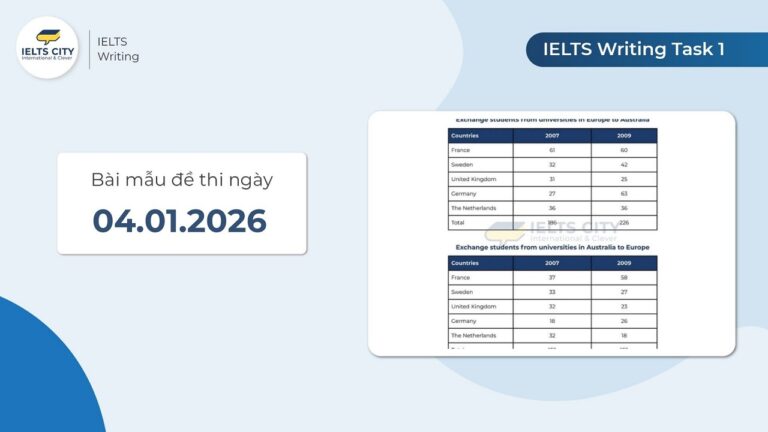Đề thi IELTS Writing Task 2 ngày 18.08.2024 là đề bài dạng Discuss both views về sĩ số lớp học trong một lớp ngoại ngữ. Để xử lý tốt chủ đề này, các bạn hãy cùng IELTS CITY xem dàn ý và bài mẫu 7.5+ phía sau nhé!

Nội dung chính
ToggleĐề thi IELTS Writing Task 2 ngày 18.08.2024
Some people think that language school be taught in small classes, while other people think the number of students in a language class does not matter. Discuss both views and give your opinion.
(Đề này được ra thi lại vào ngày 19.07.2025)
Cập nhật đề thi thật mới nhất tại:
Dàn ý
Introduction:
- Briefly introduce the topic: The debate regarding the optimal size of language classes.
- State your thesis: While both small and large classes have their advantages, the ideal class size depends on individual learning needs.
- Preview your main points: You will discuss the arguments for small classes (personalized instruction, individual attention) and large classes (diverse learning environment, community building), and then present your opinion.
Body Paragraph 1:
- Topic sentence: Advocates for small classes argue that they allow for greater individualized attention and interaction.
- Supporting points:
- Tailored instruction, personalized feedback, addressing learning gaps, reduced intimidation, faster progress, increased confidence.
Body Paragraph 2:
- Topic sentence: However, proponents of larger classes argue that they offer a more diverse learning environment and can foster a sense of community.
- Supporting points:
- Exposure to a wider range of perspectives and accents, stimulated engagement, dynamic interaction.
Conclusion:
- Restate your thesis: The ideal class size is contingent upon specific learning objectives and individual needs.
- Summarize your main points: Discuss the benefits of both small and large classes.
- Call to action: Emphasize the importance of a balanced approach, catering to diverse needs regardless of class size.
Kiến thức cần nắm:
Bài mẫu
The optimal size of a language class is a subject of ongoing debate, with proponents of both small and large classes advocating for their respective merits. While some believe that small classes provide a more personalized and effective learning environment, others contend that the number of students has little impact on the quality of education. This essay will explore both sides of the argument before presenting my own perspective.
Advocates for small classes argue that they allow for greater individualized attention and interaction. In smaller groups, teachers can tailor their instruction to the specific needs and learning styles of each student, providing personalized feedback and addressing individual learning gaps. Furthermore, students have more opportunities to engage in active conversation and practice their language skills in a less intimidating setting. This personalized approach can lead to faster progress and increased confidence in language acquisition.
However, proponents of larger classes argue that they offer a more diverse learning environment and can foster a sense of community amongst students. In larger groups, students are exposed to a wider range of perspectives and accents, which can enhance their understanding and appreciation of the nuances of language. Additionally, the dynamic interaction between multiple students can stimulate greater engagement and participation, creating a more vibrant and stimulating learning experience.
In my opinion, the ideal class size is contingent upon the specific learning objectives and the individual needs of the students. While small classes offer the benefit of personalized instruction and individual attention, larger classes can provide a more dynamic and stimulating learning environment. In general, I believe that a balanced approach is necessary, ensuring that teachers are equipped to cater to the diverse needs of their students, regardless of class size.
In conclusion, while both small and large classes have their respective advantages and disadvantages, the most effective learning environment is one that caters to the individual needs and learning objectives of the students. A balance between personalized attention and the benefits of a dynamic and diverse learning environment is crucial for maximizing language acquisition and fostering a positive learning experience.
Đăng ký nhận tư vấn miễn phí
Ưu đãi học phí lên đến 50%
& Cơ hội nhận học bổng trị giá 2.000.000 VNĐ
Đăng ký nhận tư vấn miễn phí
Ưu đãi học phí lên đến 50%
________
Từ vựng
- Proponents (n): Người ủng hộ
- Advocate (v): Biện hộ, ủng hộ
- Merit (n): Lợi ích
- Contend (v): Cho rằng, khẳng định
- Tailor (v): Điều chỉnh, phù hợp
- Intimidating (adj): Khủng khiếp, đáng sợ
- Acquisition (n): Sự thu nhận, sự tiếp thu
- Stimulate (v): Kích thích, thúc đẩy
- Contingent (adj): Phụ thuộc vào, tùy thuộc vào
- Cater (v): Phục vụ, đáp ứng
Bản dịch
Sĩ số tối ưu của một lớp học ngôn ngữ là một chủ đề gây tranh cãi, với những người ủng hộ cả lớp học nhỏ và lớp học lớn đều biện hộ cho những lợi ích riêng của họ. Trong khi một số người tin rằng lớp học nhỏ cung cấp một môi trường học tập hiệu quả và cá nhân hóa hơn, những người khác lại cho rằng số lượng học sinh không ảnh hưởng nhiều đến chất lượng giáo dục. Bài luận này sẽ khám phá cả hai phía của lập luận trước khi trình bày quan điểm của riêng tôi.
Những người ủng hộ lớp học nhỏ lập luận rằng chúng cho phép sự chú ý và tương tác cá nhân hóa lớn hơn. Trong các nhóm nhỏ hơn, giáo viên có thể điều chỉnh bài giảng của họ cho phù hợp với nhu cầu cụ thể và phong cách học tập của mỗi học sinh, cung cấp phản hồi cá nhân hóa và giải quyết các khoảng trống học tập cá nhân. Hơn nữa, học sinh có nhiều cơ hội hơn để tham gia vào các cuộc trò chuyện tích cực và thực hành kỹ năng ngôn ngữ của họ trong một môi trường ít đáng sợ hơn. Cách tiếp cận cá nhân hóa này có thể dẫn đến tiến bộ nhanh hơn và tăng cường sự tự tin trong việc tiếp thu ngôn ngữ.
Tuy nhiên, những người ủng hộ lớp học lớn hơn cho rằng chúng cung cấp một môi trường học tập đa dạng hơn và có thể thúc đẩy tinh thần cộng đồng giữa các học sinh. Trong các nhóm lớn hơn, học sinh được tiếp xúc với nhiều quan điểm và giọng nói khác nhau, điều này có thể nâng cao sự hiểu biết và đánh giá cao về những sắc thái của ngôn ngữ. Ngoài ra, sự tương tác năng động giữa nhiều học sinh có thể thúc đẩy sự tham gia và tham gia nhiều hơn, tạo ra một trải nghiệm học tập năng động và kích thích hơn.
Theo tôi, sĩ số lớp học lý tưởng phụ thuộc vào các mục tiêu học tập cụ thể và nhu cầu cá nhân của học sinh. Trong khi lớp học nhỏ mang lại lợi ích của việc hướng dẫn cá nhân hóa và sự chú ý cá nhân, lớp học lớn hơn có thể cung cấp một môi trường học tập năng động và kích thích hơn. Nhìn chung, tôi tin rằng cần có một cách tiếp cận cân bằng, đảm bảo rằng giáo viên được trang bị để đáp ứng nhu cầu đa dạng của học sinh của họ, bất kể sĩ số lớp học.
Kết luận, trong khi cả lớp học nhỏ và lớn đều có những ưu điểm và nhược điểm riêng của chúng, môi trường học tập hiệu quả nhất là môi trường đáp ứng nhu cầu cá nhân và mục tiêu học tập của học sinh. Sự cân bằng giữa sự chú ý cá nhân và những lợi ích của một môi trường học tập năng động và đa dạng là điều cần thiết để tối đa hóa việc tiếp thu ngôn ngữ và thúc đẩy một trải nghiệm học tập tích cực.
Cập nhật đề thi IELTS Writing đầy đủ nhất:
Cám ơn các bạn đã theo dõi hết bài mẫu đề thi IELTS Writing Task 2 ngày 18.08.2024 dạng Discuss both views band 7.5 được biên soạn bởi IELTS CITY. Chúc các bạn luyện thi IELTS hiệu quả và sớm đạt Target nhé!





















